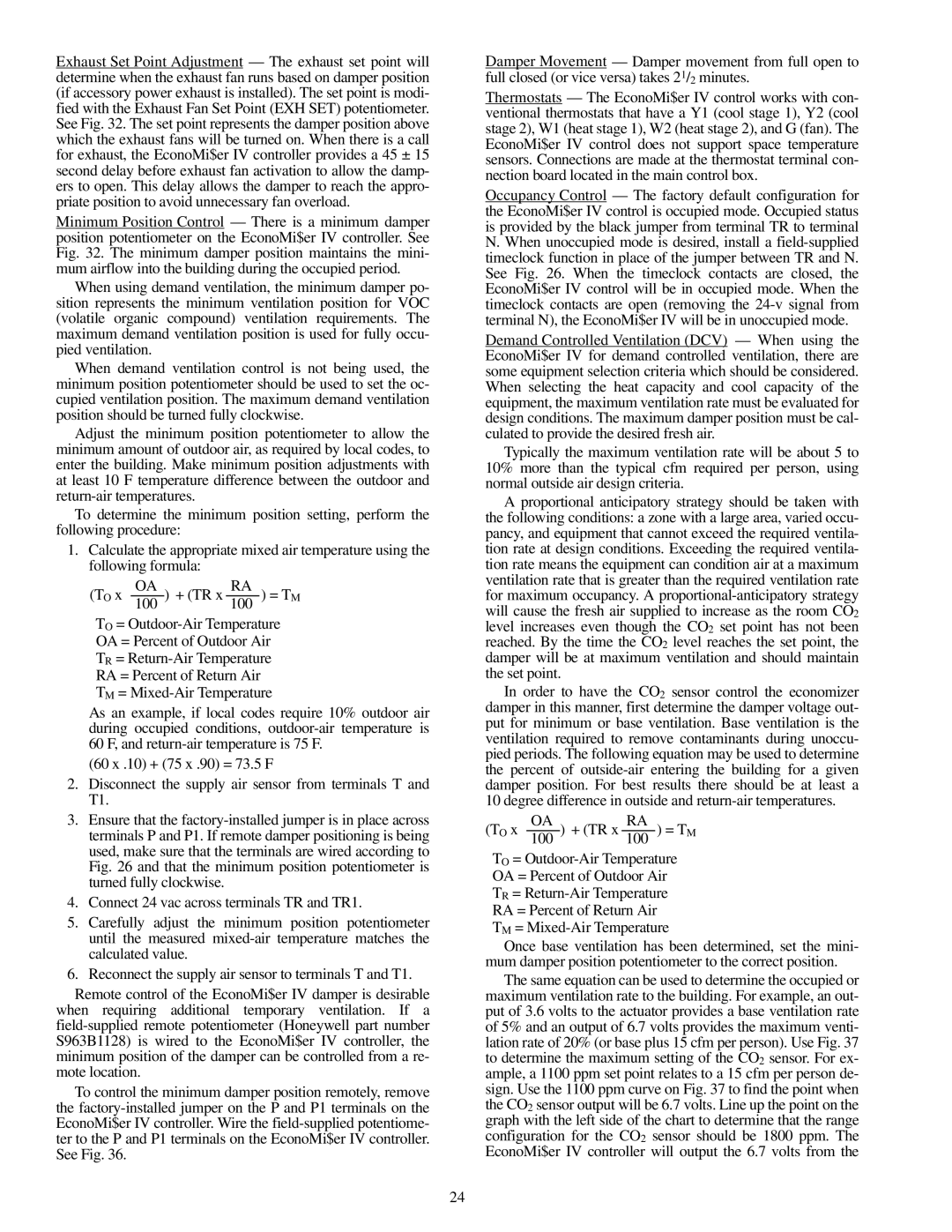
Exhaust Set Point Adjustment — The exhaust set point will determine when the exhaust fan runs based on damper position (if accessory power exhaust is installed). The set point is modi- fied with the Exhaust Fan Set Point (EXH SET) potentiometer. See Fig. 32. The set point represents the damper position above which the exhaust fans will be turned on. When there is a call for exhaust, the EconoMi$er IV controller provides a 45 ± 15 second delay before exhaust fan activation to allow the damp- ers to open. This delay allows the damper to reach the appro- priate position to avoid unnecessary fan overload.
Minimum Position Control — There is a minimum damper position potentiometer on the EconoMi$er IV controller. See Fig. 32. The minimum damper position maintains the mini- mum airflow into the building during the occupied period.
When using demand ventilation, the minimum damper po- sition represents the minimum ventilation position for VOC (volatile organic compound) ventilation requirements. The maximum demand ventilation position is used for fully occu- pied ventilation.
When demand ventilation control is not being used, the minimum position potentiometer should be used to set the oc- cupied ventilation position. The maximum demand ventilation position should be turned fully clockwise.
Adjust the minimum position potentiometer to allow the minimum amount of outdoor air, as required by local codes, to enter the building. Make minimum position adjustments with at least 10 F temperature difference between the outdoor and
To determine the minimum position setting, perform the following procedure:
1.Calculate the appropriate mixed air temperature using the following formula:
100OA ) + (TR x 100RA TO =
As an example, if local codes require 10% outdoor air during occupied conditions,
(60 x .10) + (75 x .90) = 73.5 F
2.Disconnect the supply air sensor from terminals T and T1.
3.Ensure that the
4.Connect 24 vac across terminals TR and TR1.
5.Carefully adjust the minimum position potentiometer until the measured
6.Reconnect the supply air sensor to terminals T and T1.
Remote control of the EconoMi$er IV damper is desirable when requiring additional temporary ventilation. If a
To control the minimum damper position remotely, remove the
Damper Movement — Damper movement from full open to full closed (or vice versa) takes 21/2 minutes.
Thermostats — The EconoMi$er IV control works with con- ventional thermostats that have a Y1 (cool stage 1), Y2 (cool stage 2), W1 (heat stage 1), W2 (heat stage 2), and G (fan). The EconoMi$er IV control does not support space temperature sensors. Connections are made at the thermostat terminal con- nection board located in the main control box.
Occupancy Control — The factory default configuration for the EconoMi$er IV control is occupied mode. Occupied status is provided by the black jumper from terminal TR to terminal N. When unoccupied mode is desired, install a
Demand Controlled Ventilation (DCV) — When using the EconoMi$er IV for demand controlled ventilation, there are some equipment selection criteria which should be considered. When selecting the heat capacity and cool capacity of the equipment, the maximum ventilation rate must be evaluated for design conditions. The maximum damper position must be cal- culated to provide the desired fresh air.
Typically the maximum ventilation rate will be about 5 to 10% more than the typical cfm required per person, using normal outside air design criteria.
A proportional anticipatory strategy should be taken with the following conditions: a zone with a large area, varied occu- pancy, and equipment that cannot exceed the required ventila- tion rate at design conditions. Exceeding the required ventila- tion rate means the equipment can condition air at a maximum ventilation rate that is greater than the required ventilation rate for maximum occupancy. A
In order to have the CO2 sensor control the economizer damper in this manner, first determine the damper voltage out- put for minimum or base ventilation. Base ventilation is the ventilation required to remove contaminants during unoccu- pied periods. The following equation may be used to determine the percent of
100OA ) + (TR x 100RA TO =
Once base ventilation has been determined, set the mini- mum damper position potentiometer to the correct position.
The same equation can be used to determine the occupied or maximum ventilation rate to the building. For example, an out- put of 3.6 volts to the actuator provides a base ventilation rate of 5% and an output of 6.7 volts provides the maximum venti- lation rate of 20% (or base plus 15 cfm per person). Use Fig. 37 to determine the maximum setting of the CO2 sensor. For ex- ample, a 1100 ppm set point relates to a 15 cfm per person de- sign. Use the 1100 ppm curve on Fig. 37 to find the point when the CO2 sensor output will be 6.7 volts. Line up the point on the graph with the left side of the chart to determine that the range configuration for the CO2 sensor should be 1800 ppm. The EconoMi$er IV controller will output the 6.7 volts from the
24
